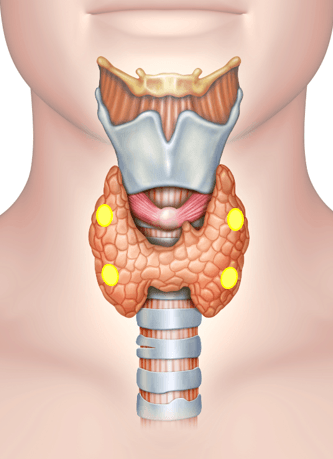Parathyroid
Parathyroid Gland
The parathyroid glands are small, pea-sized glands located near the thyroid gland in the lower part of the neck. They are usually four in number - two on each side - and weigh only 40 to 70 gm each. Two of them are usually located at the back of the thyroid along the level of the larynx (voice box) while the inferior or lower glands may be found at the bottom of the thyroid gland near the trachea (windpipe).
Their primary function is to regulate the body's calcium and phosphate levels through the production of parathyroid hormone (PTH). It helps regulate calcium levels in the blood by acting on various parts of the body. PTH stimulates the release of calcium from bones into the bloodstream. It acts on the kidneys by enhancing the reabsorption of calcium from urine back into the bloodstream while promoting the excretion of phosphate. The hormone also indirectly increases the absorption of calcium from the intestines in addition to decreasing phosphate levels in the blood by promoting its excretion through the kidneys.
Disorders of the parathyroid glands can lead to abnormalities in calcium levels. Overproduction of PTH can lead to increased calcium levels in the blood causing hyperparathyroidism. Contrastingly insufficient production of PTH causes low calcium levels in the blood, called hypoparathyroidism.

Hyperparathyroidism
Diagnostic & Intraoperative Tools
Parotidectomy
Parathyroidectomy or Parathyroid Surgery is a surgical procedure performed to remove one or more of the parathyroid glands, typically due to overactivity or disease.
Minimally invasive parathyroidectomy involves a small incision often less than 2-3 cm in a skin crease in the lower part of the neck. The parathyroid glands are exposed once the thyroid gland is lifted out of the way. The affected enlarged parathyroid gland(s) is then removed. It utilises preoperative techniques like ultrasound and Sestamibi scan paving the way for such small incisions, shorter operations and more reliable outcomes. Rapid PTH Assay is also taken in regular intervals during parathyroidectomy.
Intraoperative nerve monitoring is also used to identify and avoid damage to recurrent laryngeal nerve supplying the voice box.
The extent of parathyroidectomy varies between pathologies and presentations which could be any of the following:
Minimally invasive parathyroidectomy/focused parathyroidectomy
Minimally invasive video assisted parathyroidectomy
Unilateral/bilateral neck exploration parathyroidectomy
Radio-guided parathyroidectomy
Central compartment neck dissection ± thymectomy
Parathyroidectomy is performed under general anaesthesia. Post surgery, the patient will probably spend the night in the hospital. Recovery time is usually one week during which they are advised to be off work.
Dr Naveed Basheeth & Parathyroid Surgery Technologies
Dr Naveed Basheeth is a pioneer in minimally invasive thyroid and parathyroid surgery. Having immense experience from some of the best institutes in the world such as Tata Memorial, Cambridge University, Dalhousie University, and premier training hospitals in Dublin, Cork, Ireland, he has successfully helped innumerable patients with thyroid and parathyroid pathologies.
Dr Basheeth performs Minimally Invasive Radio-guided Parathyroidectomy (MIRP) which is now possible for the removal of one or more glands but with shorter incisions and streamline treatment to achieve optimal results for the patient. Following a radionuclide sestamibi tracer injection, a gamma probe is used to detect the radioactivity in vivo and remove the abnormal glands.
He also utilises technologies like Indocyanine Green Tracer (ICG) - for intraoperative visualisation; intraoperative nerve monitoring (IONM); and intraoperative PTH assay, depending on the complexity of the condition, to achieve optimum results for his patients.








